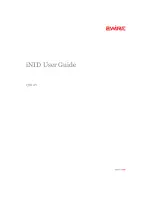
Intel
®
81341 and 81342 I/O Processors
December 2007
Developer’s Manual
Order Number: 315037-002US
573
DDR SDRAM Memory Controller—Intel
®
81341 and 81342
Utilizing the DDR SDRAM chip selects
CS[1:0]#
and internal bank selects
BA[2:0]
,
the DMCU keeps a maximum of eight pages open simultaneously for 512 Mbit
DDR-2 SDRAM devices and sixteen pages for 1GBit or 2 Gbit DDR-2 SDRAM devices.
The number of available pages depends on the memory subsystem population. A single
512 Mbit DDR-2 SDRAM device allows four pages, whereas a 1 Gbit or 2 Gbit DDR-2
SDRAM device allows eight pages.
Open pages allow optimal performance when a read or write occurs to an open page.
Multiple open pages allow multiple memory segments to be open simultaneously and is
well-suited for the 81341 and 81342 system environment. The DMCUs paging
algorithm is detailed in
Section 7.3.3.5, “Page Hit/Miss Determination” on page 589
.
The waveforms illustrating the performance issues are in
Section 7.3.3.10, “DDR SDRAM Write Cycle” on
Table 346. DDR2 SDRAM Interface Signals
Pin Name
Description
M_CK[2:0]
DDR SDRAM Clock Out — Three (positive lines) output clocks driven to Unbuffered DIMMs
supported by the
81341 and 81342. Registered DIMMs only use
M_CK[0]
which drives the
Section 7.3.6, “DDR SDRAM Clocking” on page 616
describes the
DDR SDRAM clocking strategy for both Unbuffered and Registered DIMMs.
M_CK[2:0]#
DDR SDRAM Clock Out — Three (negative lines) output clocks driven to Unbuffered DIMMs
supported by the 81341 and 81342. Registered DIMMs only use
M_CK[0]#
which drives
the input to the on-DIMM PLL.
Section 7.3.6, “DDR SDRAM Clocking” on page 616
describes
the DDR SDRAM clocking strategy for both Unbuffered and Registered DIMMs.
M_RST#
DDR Registered DIMM Reset — Re-initializes registered DIMM during a
P_RST#
assertion or
whenever internal bus reset bit is asserted in the PCSR.
Section 3.16.41, “PCI Configuration
and Status Register - PCSR” on page 331
describes internal bus reset sequence.
CKE[1:0]
Clock enables — One clock after
CKE[1:0]
is de-asserted, data is latched on
DQ[63:0]
and
CB[7:0]
. Burst counters within DDR SDRAM device are not incremented. De-asserting this
signal places DDR SDRAM in self-refresh mode. For normal operation,
CKE[1:0]
must be
asserted.
CS[1:0]#
Chip Select — Must be asserted for all transactions to DDR SDRAM device. One per bank.
BA[2:0]
DDR SDRAM Bank Selects — Controls which of the internal DDR SDRAM banks to read or
write. Only
BA[1:0]
are used for 512 Mbit technology type, whereas
BA[2:0]
are used for
1 Gbit
and 2 Gbit
technology types. Note that 81341 and 81342
supports only DDR2
512 MBit and 1 Gbit
and 2 Gbit
technology types.
MA[10]
Address bit 10 — When high during a read or write command, auto-precharge occurs after
the command. During a
row-activate
command, this bit is part of the address (see
Auto-precharge is
not
supported by the 81341 and 81342
.
MA[13:0]
Address bits 13 through 0 — Indicates the row or column to access depending on the state
of
RAS# and CAS#
(see
).
DQ[63:0]
Data Bus — 64-bit wide data bus.
CB[7:0]
ECC Bus — 8-bit error correction code which accompanies the data on
DQ[63:0].
DM[8:0]
Data Bus Mask — Controls the DDR SDRAM data input buffers. Asserting
WE#
causes the
data on
DQ[63:0]
and
CB[7:0]
to be written into the DDR SDRAM devices.
DM[8:0]
controls this operation on a per byte basis.
DQS[8:0]
,
DQS[8:0]#
Data Strobes — carry the differential strobe signals, output in write mode and input in read
mode for source synchronous data transfer.
WE#
Write Strobe — Defines whether or not the current operation by the DDR SDRAM is to be a
read or a write.
RAS#
Row Address Strobe — Indicates that the current address on
MA[13:0]
is the row.
CAS#
Column Address Strobe — Indicates that the current address on
MA[13:0]
is the column.
ODT[1:0]
On Die Termination signals control — turns on SDRAM termination during writes
M_VREF
SDRAM Voltage Reference — is used to supply the reference voltage to the differential
inputs of the memory controller pins.
MCAL[1:0]
Memory Calibration — Connected to an external calibration resistor. Memory output drivers
can reference the resistor to dynamically adjust slew rate and drive strength to compensate
for temperature and voltage variations. M_CAL[0] is connected through a 25-ohm 1%
resistor to ground. M_CAL[1] is connected through a 300-ohm 1% resistor to ground.
















































